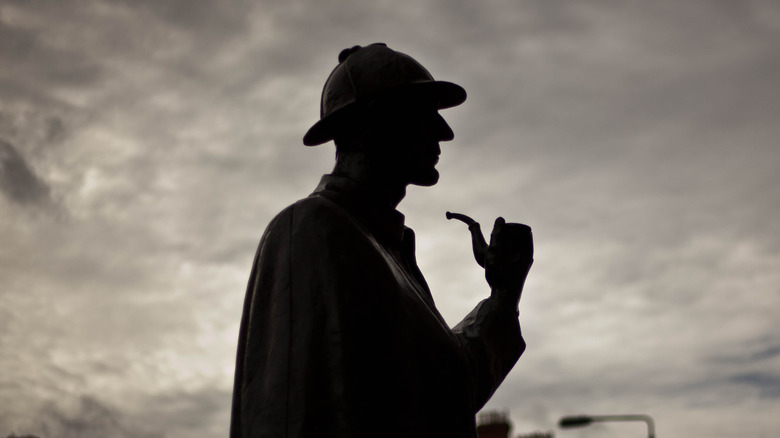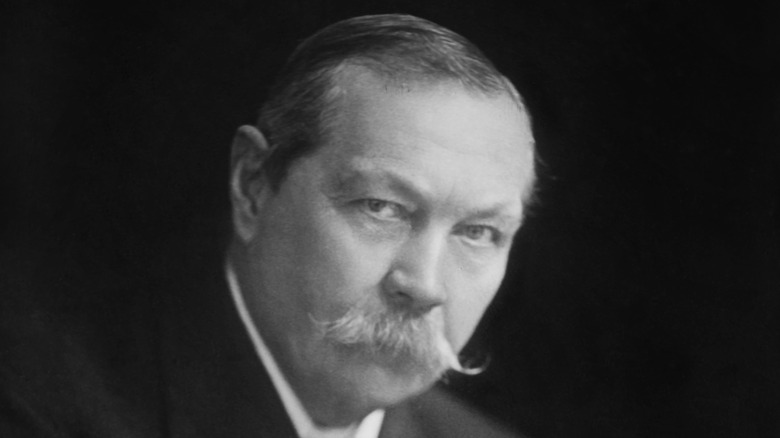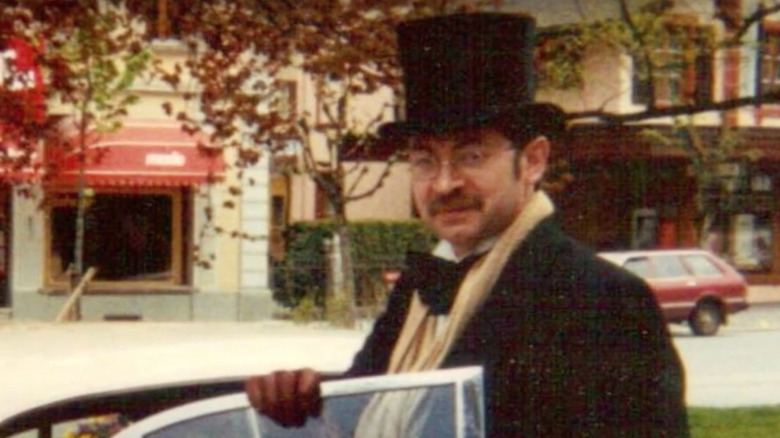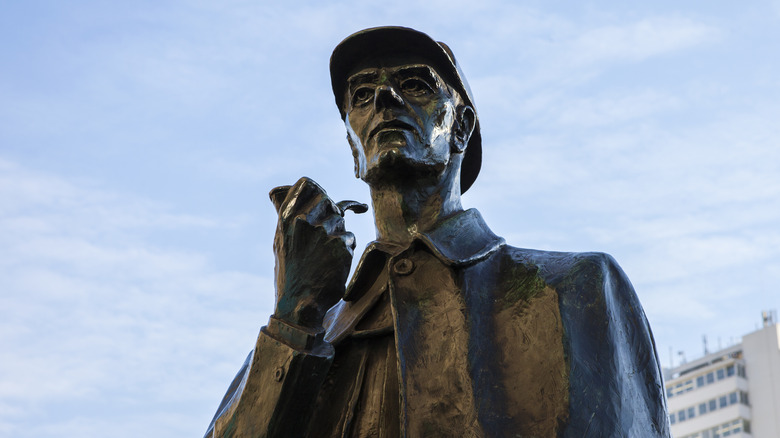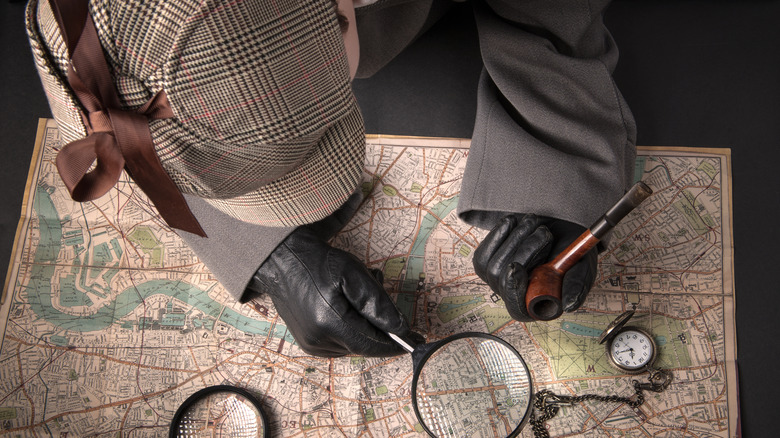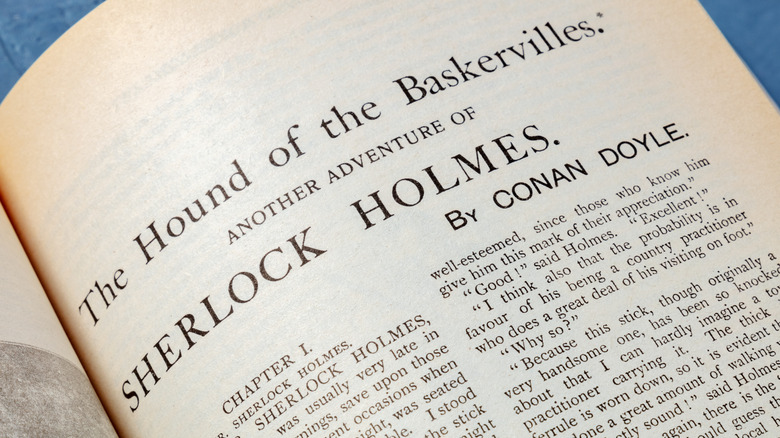The Peculiar 2004 Death Of A Sherlock Holmes Expert
Though Sir Arthur Conan Doyle might be best known for the mysteries documented in his Sherlock Holmes stories, it seems as if his real life had almost as many secrets as the tales of the famed literary detective. While these enigmas range from his conflicts with other important figures of the day to his interest in the paranormal and the occult, there is one that stands out: the missing papers.
According to Conan Doyle lore, a cache of dozens of personal letters, unfinished manuscripts, and journal entries from the author went missing shortly after his death in 1930. In the decades following, Sherlock Holmes fanatics were on a mission to find the trove of documents, which was estimated to be worth millions of dollars, per The New Yorker.
However, finding the missing papers quickly became a major challenge, with so many twists and turns and misfortunes that befell the seekers that many have deemed the missing papers "cursed." This curse was best highlighted by Richard Lancelyn Green, a scholar who was the foremost expert on all things Sir Arthur Conan Doyle and Sherlock Holmes. Green desperately wanted to write the definitive biography on the famed author and was determined to find the whereabouts of the missing papers to make his biography complete. The mission would lead him on a quest that involved Russian aristocracy, contested wills, and — scariest of all — Green's own death.
The start of the journey
Green began researching what happened to the missing cache of letters and discovered that Adrian Conan Doyle, one of the author's five children, had taken all his father's papers and hidden them in a medieval Swiss castle. However, Green discovered that while Adrian's possession of the papers was with his siblings' knowledge and approval, Adrian had gone behind his siblings' backs and tried to sell some of the documents on the sly, per The New Yorker.
However, Adrian reportedly had a heart attack in the middle of the deal and the stolen documents went missing. Green continued to follow the trail, meeting with multiple relatives, Sherlock Holmes fanatics, and collectors of fine goods. He eventually discovered that the missing papers were in the hands of Dame Jean Conan Doyle, the youngest of the author's children.
Dame Jean told Green that she kept her ownership of the papers out of the spotlight because of family squabbles. However, she explained that she was bequeathing the collection to the British Library as part of her will.
But after Dame Jean died in 1997, nothing happened and the trail went cold until March 2004, when news broke that the papers were found and going up for auction at Christie's, per CNN. This would mean that instead of going to the British Library, the papers would be scattered across the world in the hands of private collectors.
The fight for the papers gets creepy
Green was not only outraged over the auction — but suspicious. Soon, he quickly began telling people that he had proof that the papers had been stolen and therefore could not be sold at auction. According to The New Yorker, Green had a copy of Dame Jean's will, which stated that she would give "to The British Library all ... my late father's original papers, personal manuscripts, diaries, engagement books, and writings."
Green became relentless in his pursuit to stop the sale of the documents, even bringing the matter up with Parliament. But there were consequences. Green started expressing fears that someone was following him, referring to his stalker as a mysterious "American." He had dinner with a friend and even pointed out a car that he said had been tailing him.
The tale became stranger: Green sent his sister, Priscilla West, a note with three phone numbers that he asked to keep "safe" and notified several journalists that he feared for his safety. Green shared his concerns with more than reporters. According to The New Yorker, shortly before his death, he had a phone call with John Gibson, one of his closest friends.
"I'm worried," Green reportedly confessed. "What? You fear for your life?" Gibson replied. "I do." It was the last conversation Gibson would ever have with his friend.
A mysterious death
On March 27, 2004, Green was found dead in his bed, surrounded by stuffed animals and a bottle of partially finished gin. The manner of death was particular: it is known as garroting, or a type of strangulation achieved by using a small cord. In Green's case, the cord was a black shoelace that had been tightened around his throat with a wooden spoon.
According to The New Yorker, the police found no sign of forced entry and no missing items — two major aspects that suggested Green's death was suicide. But friends pushed back against the characterization. For starters, they noted that when they had called Green out of concern, his answering machine's message was no longer his own greeting but an American voice saying "sorry, not available." The three phone numbers in the note to Green's sister was similarly never investigated.
Even stranger was the fact that garroting would be an extremely difficult, if not impossible, way to commit suicide. Gibson noted that most people pass out before achieving total asphyxiation and compared it to strangling oneself with bare hands.
Adding credence to the idea of foul play was the testimony of Sir Colin Berry, the president of the British Academy of Forensic Sciences. Berry told the coroner on the case that he had only seen an example of suicide by garroting once throughout his 30-year-career, suggesting the method of suicide was an anomaly at best, and suspicious at worst.
Green's downward spiral leaves doubts
Though police suspected suicide, they had no answers for the strange voice message or the lack of the suicide note and decided to leave the case with an open verdict. However, investigators have pointed out that the Sherlock Holmes fanatic had been suffering from a major mental health crisis in the weeks before his death. Even West, Green's sister, admitted that he had seemed almost "delusional" in his final days.
West said, "He said he felt the world was 'Kafkaesque' ... He said he hadn't slept for several nights. At one point he said he wasn't sure I was me. It was because I was very concerned about his state of mind that I went to see him on the Saturday," according to The Observer (via The Guardian). However, despite his obvious distress, West maintains that she did not believe Green took his own life.
"The coroner's open verdict is the right one. Richard was very disturbed but I wouldn't have said suicidal," she added.
Green's mental status also left a mark on Nicholas Utechin, the editor of the Sherlock Holmes Journal. However, Utechin found Green's behavior so odd that he has little doubt that suicide was the cause of death.
"I spoke to him by phone for half an hour a few hours before his death," Utechin recalled. "At one point I said: 'Richard, you're losing it,'" he continued, adding that Green had sounded "deranged."
Where the case stands now
Friends and family have decamped to two sides of the case: some believe that Green was descending into madness and took his own life, while others believe he was the victim of a crime because of his determination to stop a multi-million dollar sale. However, there is one third option: perhaps Green had meticulously planned his suicide to look like murder — which was fittingly a plot twist in the Sherlock story "The Problem of Thor Bridge," one of Conan Doyle's final works.
"I think he wanted it to look like murder," admitted Gibson, Green's friend. "That's why he didn't leave a note. That's why he took his voice off the answering machine. That's why he sent that message to his sister with the three phone numbers on it. That's why he spoke of the American who was after him. He must have been planning it for days, giving us false clues. He created the perfect mystery" (via The Telegraph).
To this day, Green's death remains open, and Scotland Yard has stated that it would reexamine the case if new evidence were to emerge, per The Guardian. However, no new clues have materialized in the nearly two decades since Green's death, and the case has ultimately remained a mystery – befitting the ultimate mystery fanatic.
